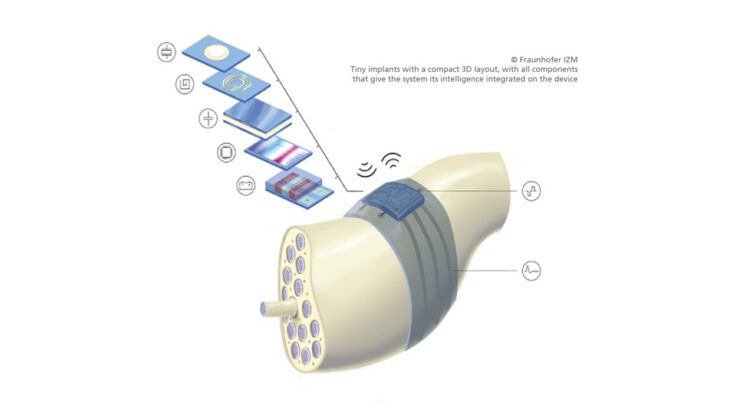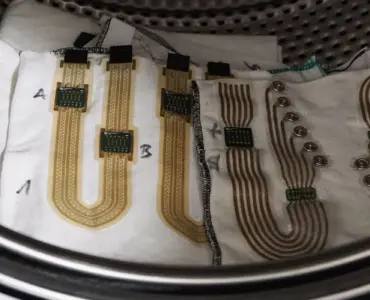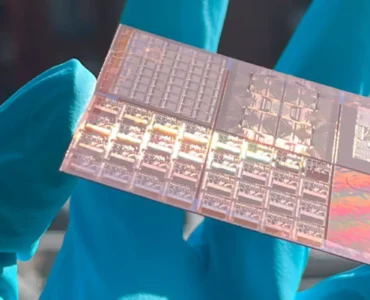Bioelectronic medicines (otherwise known as electroceuticals) are expected to have a significant influence on the conditions of life in our modern society. In a few years, electroceuticals will be able to treat diseases and ailments such as diabetes, asthma, and Parkinson’s with electrical impulses, without drugs that can negatively affect the human body.
One of the research groups from Fraunhofer IZM stays at the root of the design and fabrication of active neural interfaces, namely flexible implants tailored for the central or peripheral nervous system. The researchers from Fraunhofer IZM, Dr. Vasiliki Giagka and Erik Jung, express an opinion on this research statement.
Can you introduce bioelectronic medicine? What is it and how can we use it?
Vasiliki Giagka: We have been using implants to induce electricity in the body for a while now. The first device, a pacemaker, was implanted 60 years ago and back then the implants were quite bulky. Since then, many improvements have been made in electronics. We foresee that the next generation of implantable devices will be made very, very small and will be able to interconnect with each other. Therefore, we are talking about miniature devices that are working in a network inside a body. They cooperate, they exchange data, and they record signals from our body in order to develop a personalized treatment. Creating specific therapies this way is similar to how we adjust the dosage of drugs. The devices are implanted close to the nerves in order to keep side effects minimal. Especially diabetes, asthma and Parkinson´s disease can be treated very effectively with those procedures and there is yet big potential to treat many more disease.
Could you please explain how the future treatments might look?
Vasiliki Giagka: Let’s imagine.We have a nerve with its different fascicles, which each contains many neurons and wrapped around it there is this bioelectrical device, which is powered wirelessly. The different elements in the device are all kinds of electronic components and structures like electrodes – which are for stimulating and recording, antennas, and processing units. To understand the working principle of such an approach you need to know that information in human bodies is transmitted either electrically or chemically. So far, with pharmaceuticals, we have been interfering in the chemical information flow. Now, the idea is to record, control, and stimulate the information that is transmitted electrically.
How can we place the implant near the nerve?
Vasiliki Giagka: That is a very good question, because we are facing some problems here. Implantation by needle is quite complicated, because we are talking about extremely tiny structures. There is also the idea of the micro robots, as they are known, but as yet, these are only science fiction.
Erik Jung: It might be possible, for some organs, not to need to wrap the implant around a nerve, but rather to trigger stimulation of an organ, where you get a hold in the inside by deploying a catheter for example.
You speak about a network of implants. How many implants do we need in our body to gain enough information?
Vasiliki Giagka: That is not a question that we can easily answer. It really depends on the specific condition that you would like to treat. It also depends on how the treatment is going to happen. For the majority of conditions, we are still at a stage where we have to understand where it makes sense to intervene, what kind of signals we can use, and where we can apply the treatment. So we do not know yet how many implants we need.
Can you name the positive and negative impacts of this technology?
Erik Jung: The great advantage is that we will not be dependent on drugs any longer, which often cause side effects.
Vasiliki Giagka: Yes! Because drugs usually affect the whole body. By contrast, treatments with bioelectronic devices can be applied punctually and exclusively to that part of the body where a treatment is necessary. In particular, we aim to induce local treatment only to the targeted organ. Furthermore, we will be able to reorganize neuron structures that may, for example, have been damaged in a traumatic accident, in order to regain the nerves functionality. This is called neuron modulation and by that we hope to cure patients who have lost part of their senses or body functions. Essentially we modulate the neurons so that they perform the way that they are supposed to. For example, we envision helping patients who have lost the ability to control their bladder. Bioelectronic devices could measure bladder volume constantly and send an indication when a person is supposed to go to the toilet. In addition, the device could stop involuntary emptying of the bladder by high frequency stimulation of the nerve that conducts the signals for that process.
Do you see any negative effects of this technology?
Erik Jung: One of the things we need to take care of is data security. Because once the devices are able to communicate and allow information to pass, they become vulnerable. Therefore, allow me to mention the Fraunhofer cooperation Berlin Center for Digital Transformation, which deals with such data security aspects. There is already one reported case of researchers being able to hack a pacemaker. Although that happened in a laboratory setting, it shows the dimension of the safety issue.
Vasiliki Giagka: Just to make it clear, implants that are already being used like pacemakers are not in danger of being hacked in real life because wireless communication is not yet implemented. The actual problem we are facing is that future devices will have to communicate to reach the next tier of performance and service. So we are dreaming of a more connected and therefore smarter and more useful system of devices.
Erik Jung: In addition, there are also socio-economic as well as ethical issues. On one hand, implantation is a surgical procedure, which comes with a hardware device and typically with high initial costs. It may turn out that patients who have better health insurance can benefit from that, while others have to take drugs such as we have always used before, which in the long run will limit their quality of life. Therefore, there might be division by social class. Furthermore, the fear of creating super senses was expressed, at least within some physical limitations. This has already been discussed with cochlear implants as well as with retinal implants. Of course, we are still far away from the ability to hear ultrasound or seeing infrared, but, that notwithstanding, the technical capabilities are there and clearly military use cases can be foreseen. Imagine you could trigger signals that suppress anxiety or panic so that you always have a super level-headed person who is just at the right level of adrenaline that allows him or her to perform at his or her maximum peak. Even though we have to consider those visions, they are science fiction for now. Right now, we are facing challenges that are much more basic.
Vasiliki Giagka: Yes, I absolutely agree with you. The actual building process of such implants still bears so many difficulties because we need to cram many functionalities in a very tight area. In addition, once they are placed deep inside the body, the implants will need to be powered wirelessly. That presents kind of a dilemma, because the bigger the device, the easier it can be powered, but the more challenging it is to implant it. Even more importantly, the material the device is made of must be highly resistant to guarantee a long lifespan.
Can you tell us about other use cases?
Vasiliki Giagka: We have also been looking at spinal cord stimulation for restoring locomotion. Most people with spinal cord injuries suffer from being unable to move their arms and legs. By electrical stimulation of the spinal cord, we see a way of restarting some locomotion, but there are as yet many things to be optimized for this application.
Erik Jung: Actually, this kind of electrical stimulation is already used in the treatment of neural disorders, but without any devices being implanted yet. Therefore, you typically have to be in a doctor setting; there, you get cuffs around your ankle, for example, or your arm, and then you do some repetitive exercises that are supported by the electrical stimulation. The combination of doing something voluntarily and the electrical stimulation, which is coordinated simultaneously, augments the reprocessing of the neural pathway immensely. Just recently, I heard about a girl aged 17 who had experienced neural trauma and lost the feeling in her legs. Anyway, by applying the treatment I just mentioned, she was able to run a hundred-meter sprint six months after the accident. Which I think is an unbelievably huge improvement.
Which materials do you use for this technology?
Vasiliki Giagka: We use polymers that have been approved for use in the human body, for example silicone rubber and precious metals like gold or platinum. In addition, of course silicon, as the workhorse of the semiconductor industry, is used for the electronics and needs to be protected from the body’ environment.
What are the next steps in the development of the technology ? In how many years can we do the first human tests?
Vasiliki Giagka: We can, as yet, barely foresee how many years we still need. Some companies may claim successes – at a very basic level – but we have to understand that we, as a community, are still at a very early stage of the research. The next step is to find appropriate tests in our laboratories to ensure devices work properly once they are implanted. Right now, we care about making the devices tinier and more reliable.
Erik Jung: It is hard to predict, because in order to conduct human trials in an ethically acceptable situation, we need to achieve at least a decent level of reliability in each part of the whole process. With this in mind, I would like to underline that we are talking about a multidisciplinary approach that includes dozens of scientists globally with different backgrounds. There are neuroscientists, neurosurgeons, computer scientists, experts in electronics, and packaging, as well as mechanical engineers, who are all highly specified in their discipline but have to interact and work together to achieve a holistic progress.
And what projects do we have here at IZM?
Vasiliki Giagka: I am working with my team in a project called Technologies for Bioelectronic Medicine that was funded by a Fraunhofer program (Fraunhofer Attract).We are also already involved in a number of European cooperative projects that have similar electroceutical concepts in their goals.
Could you tell us about the competitive situation on this market?
Erik Jung: Clearly, at this level of research, my assessment would be that everyone is competing with each other only to a certain level. What I mean is that we are not competing for market share based on maximum revenue. Instead, we are competing with other researchers to reach the next stage of knowledge. As we need a very large group of people to take a step forward in basic research, I guess it is even better to say that the situation right now is synergistic rather than competitive. Of course, that will change when a certain technology matures to the extent that you can actually make money out of it. However, there is competition with respect to research funds for Horizon 2020 projects, for example, or national funds just due to the nature of these calls.
Do we have any collaborations in this field?
Erik Jung: We are working together with partners in Germany and all of Europe as well as in the US and some Asian countries – you see this is really a global community.
Which standards are still needed to advance bioelectronics?
Erik Jung: Lawmakers have just modified the ISO 10993 standard for biocompatibility. They have also changed the framework of the Medical Device Regulation in order to improve patient safety. That will also push our technology to adhere to that. However, there is a lack of standards for tests, which of course provides less incentive to companies to develop new products. Anyway, standards will be developed alongside our research findings and, fortunately, there are already interest groups including research institutes, universities, and protagonists from industry who which are discussing and organizing the development of standardization.
This interview was conducted by Yulia Fedorovich from Fraunhofer IZM’s Marketing & Business Development department.





Like!! Great article post.Really thank you! Really Cool.
Really appreciate you sharing this blog post.Really thank you! Much obliged.
The evolution of medical science has really evolved quickly.